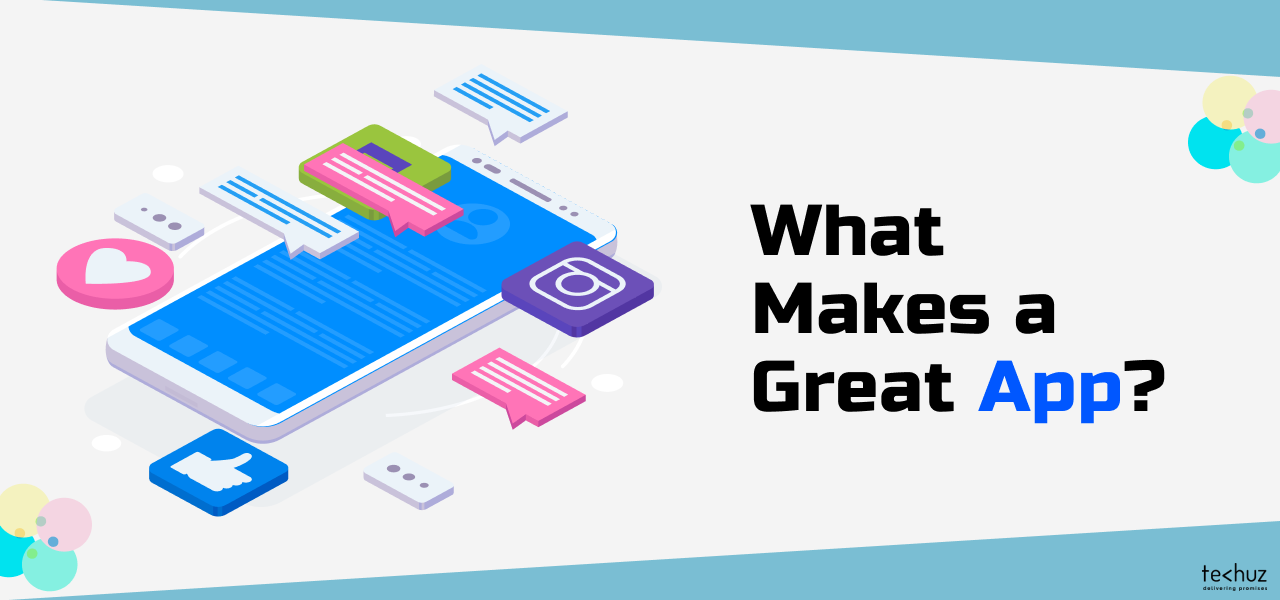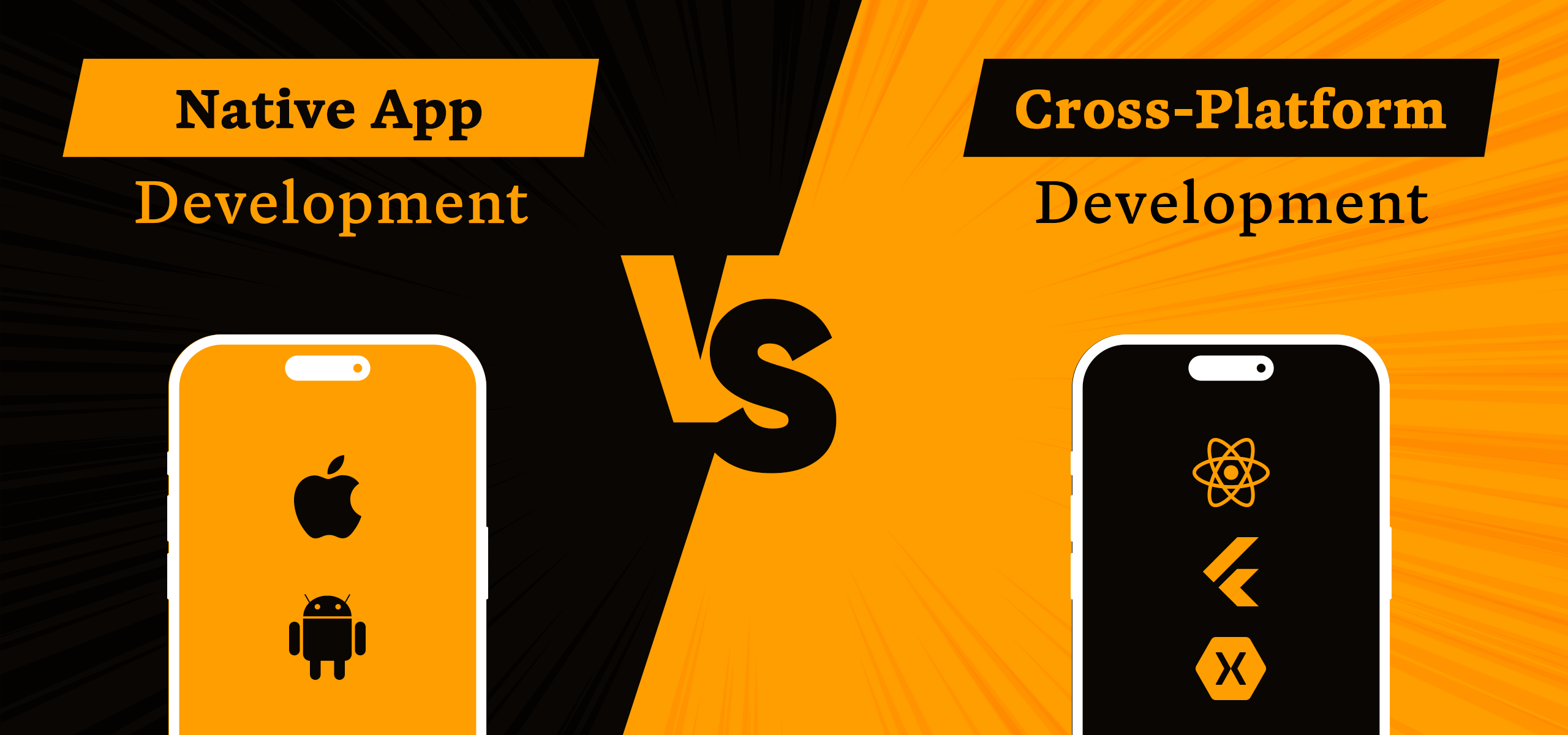Posted on
August 26, 2021
Updated on
April 24, 2024
Read time
 12 mins read
12 mins read
Quick summary: A good app solves user needs and provides value. It also boosts user engagement and retention, providing benefits to the business. Some common and important elements that make such a good app include — solid market research, seamless design and usability, high performance, appropriate technology, security, thorough testing, proper marketing and monetization strategy, excellent user support, and continual improvements.
Carefully look at these astonishing stats:
- As of 2021, there are over 4.8 million apps in both app stores.
- An average user has 80 apps on the phone but uses only 9 apps daily.
- Only 29% of the apps on the phone make it beyond 90 days.
Well, what does this data mean?
It clearly shows that only a few in the overcrowded app market are able to hook users. These are the apps that users like, recommend to others, and even spend money on. Moreover, they are also featured in the app stores. These are the apps that we consider successful. And in this article, we have explained 10 key elements necessary for creating such apps.
We answer all these questions and more in this blog:
What Makes a Good App?
Common elements that make a good app include the following:
- Market and Audience Research
- Flawless Design
- Performance
- Right Development Technology
- Rigorous Testing
- Security
- App Marketing Strategy
- Right Monetization Strategy
- Excellent User Support
- Continual Improvements and Updates
1. Market and Audience Research
Research is a crucial aspect of any successful app. It provides you the insights to create an app based on real data rather than assumptions. And this is quite essential for the app’s success.
According to CB Insights, 35% of startups fail because there was no market need for their product. Good research can save you from that by helping you understand who’ll use your app — the audience and what problem will it solve — market need. Also, the decisions for the later stages of design, development, and marketing largely depend on the research.
As a part of the research, you must evaluate your competitors, use analytics to get vital metrics and trends, collect user demographics, and conduct surveys for qualitative and quantitative data. In case your app idea is unique and doesn’t have enough market data, you can go a step further by building a minimum viable product to gather the data. There are many minimum viable product examples that can help you test your hypothesis and collect insights without actually building an app.
2. Flawless Design
Design can make or break your app. After all, it’s the way your app looks, feels, and functions. Get it right and you’ll get higher engagement, retention, and brand reputation. So we recommend investing ample time during the design phase, particularly in UX. Here’re some of the quick tips that you should consider.
Create a great first-time experience
Hook the users from the start with pleasing onboarding to help them understand how to use the app and the value it provides. Also, avoid any friction that can bounce the users — such as unnecessary sign-in walls. Sometimes slow loading time can affect the first-time experience; you can strategically use preloaders for that.
Humanize the designs
Successful apps make users feel like they’re interacting not with the software but with a human. You can humanize your designs using personalization, expressive illustrations and visuals, functional animations, micro-interactions, and meaningful UX copies.
Minimize cognitive load
If your designs require more cognitive load, users are more likely to have a bad experience and abandon the app. So try to minimize the load by keeping the design simple, familiar screens, easy navigation, consistent design, and chunking the huge tasks into bite-sized.
3. Performance and Stability
Users expect a quick, smooth and snappy performance while using the app. Delay in load time or any lags and crashes can ruin their experience. And they won’t mind leaving the app or even uninstalling it. In fact, research by Google reports that 70% of smartphone users will switch to another app if it’s too slow. And even a minor delay from 1 second to 3 seconds increases the bounce probability by 32%. So the bottom line is, your app must maintain a high performance.
To do that, you need quality development and follow the best practices. Here’re some of the things to consider.
- Follow best coding practices
- Optimizing, resizing, and caching images
- Work on improving the app startup time
- Minimize the memory consumption
- Optimize the app for various devices (especially low-end devices)
- Utilize pre-loading/pre-fetching data where suitable
4. Right Development Technology
We know that the technology we choose impacts the features, functionalities, and in general how the app works. But there’s more to it — development cost and time to market. The right technology will help you fulfil your objectives — be it providing the native experience, developing a quick MVP to gather feedback, or launching apps for different platforms with just one codebase. Based on your needs and objectives, you may choose to use native or cross-platform technologies.
Native development
Platform-specific native technologies such as Kotlin (Android) and Swift (iOS) give the best functionalities, features, UX, and performance. There’s high customization, full access to the phone’s resources, and the potential of what you can do is pretty limitless. However, it comes with high development costs, time to market, and requires separate teams for each platform.
Cross-platform development
Cross-platform technologies are a cost-effective alternative to native. Although there are some limitations, they are capable of providing native-like functionalities, experience, and performance to a great extent. In fact, in many cases, its benefits such as cost-effectiveness, faster development, and a single codebase weigh more than its limitations. If you are a startup, with a limited budget, this could be the right option for you. Moreover, technologies like React Native and Flutter are reducing the gap between what native and cross-platform apps can do.
5. Rigorous Testing
Crashes are among the key reasons for negative reviews and uninstalls. As per a report, 96% of the users would write a bad review, while 44% would immediately delete the app for that. That’s a significantly huge number. Any app that wants to be successful cannot afford such damage. This makes it essential to remove any faults app with rigorous testing before it’s live.
“Freezing, crashing and slow responsiveness were the primary bugbears…96% (of the users) said that they would write a bad review on an under-par app, while 44% said that they would delete the app immediately.”
Your app has to perform well on various standards. This includes different functional and non-functional parameters such as usability, performance, stability, security, etc. And you have to maintain it across myriad devices, screen resolution, and usage scenarios.
While you may do your best during design and development, errors are bound to happen. Or at least there’s always room for improvement. And it’s through the testing you can further refine your app.
It’s better to consider testing early and frequently at each stage of development. So by the time the final app is ready, it’s already gone through multiple testing. Also due to a large number of mobile devices, ensure to test the app across different configurations: devices, screen size, and network.
6. Security
Since the majority of the activities — financial transactions, shopping, booking, chatting, and storing private data — are done on mobile devices and apps, security can not be treated as a good-to-have feature. It’s an indispensable part of your app.
An unprotected app with poor security is vulnerable to compromising critical user data such as personal information, payment data, medical records, etc. So as an app developer, it’s your responsibility to safeguard users’ data as well as your app’s reputation.
There are several mobile app security practices that ensure your app is secure. Even iOS and Android provide platform-specific security guidelines. Here are some of the basic mobile security requirements that an app must follow.
- Ensure proper encryption for data storing and sharing
- For confidential user data, store it locally on the device with sandboxing
- Use HTTPS and SSL protocols for transferring data between app and servers
- Keep libraries, SDKs, and other dependencies up to date.
- Always audit the third-party libraries before you use
- Perform a rigorous penetration test
- Employ proper session management
- Adhere to security compliance such as PCI DDS for payments and HIPPA for medical apps
7. App Marketing Strategy
No matter how great your app is, if it can’t reach your target audience it is certainly destined to doom. You need a strategy to raise awareness, reach the target audience, and get them to install the app. As per a survey, marketing is the number one challenge that app developers face in building the app. In fact, marketing was considered 2x times more difficult than design and development. If you are one of those who is facing a hard time marketing your app, here’re the popular app marketing tactics.
Create a landing page
Your app’s landing page is the place for your users to learn more about your app and at the same time persuade them to download it. You can also use it to signup visitors for launch notifications and gather insights even before the app is made.
Employ content marketing
Content marketing provides significantly high ROI at less cost compared to many other digital marketing channels. It can help you increase your brand awareness, build trust and authority, increase organic traffic, aid SEO and ASO, and get high-quality leads (who are more likely to download your app). You may strategically use different types of content such as blogs, videos, podcasts, infographics, etc. for your content marketing.
Work on app store optimization (ASO)
ASO is the number one driver for app discoverability. About 70% of mobile users discover new apps from app store searches, and 65% of the downloads are made after a search. Without a doubt, ASO is vital to your app’s success. So understand store ranking factors and optimize your store presence accordingly. Some of the common ranking factors in both iOS and Android app stores are app name, title, app description, app URL, reviews and ratings, and the number of downloads.
Invest in paid user acquisition
Paid user acquisition is targeting your audience to install your app via paid ad campaigns. This includes social media ads, PPC campaigns, and in-app advertising. Paid user acquisition can be the main driver of app installs when targeted to the right audience and through the right medium. However, understand that these campaigns are huge investments and you need to optimize them over time for profitability.
8. Right Monetization Strategy
A great app not only works well and attracts users but also leverages them to earn profit. There are various monetization strategies that you can use for different types of apps. The popular ones are in-app advertisements, in-app purchases(IAP), subscriptions, and selling APIs. While there are many paid apps in the app stores, the majority follow a freemium monetization model. And in fact, freemium apps are among the top grocers.
With the freemium model, you offer the app for free and then upsell premium features or in-app consumables through IAPs or subscriptions. This works great because 1.) free offering reduces the acquisition fiction, and 2.) free apps attract mass, which is great to earn ad revenue.
Whatever monetization model your choose, make sure to consider your audience, app type, other apps in the categories, app offerings, cost structures, and local pricing factors to maximize your revenue.
9. Excellent User Support
User support plays a crucial role throughout the user journey, but it is especially important during the retention and advocacy phase (after the app is installed or purchased).
Promptly answering queries and solving user problems shows that you care which results in happy and loyal users. This brings along benefits such as higher engagement, retention, referrals, positive reviews, and lifetime value (LTV) — all that’s necessary for the app’s success. So ensure you’re providing superb user support.
Here are some of the things that you need to consider.
- Respond to store reviews — especially when your app is recently released. And always reply and resolve negative reviews.
- Provide a good knowledge base such as FAQs and articles so that they can solve issues quickly on their own.
- Provide both internal and external contact channels such as in-app feedback and email.
- Promptly address payment or purchase-related issues.
- Keep the interaction human while communicating.
10. Continual Improvements and Updates
A mobile application is never finished; it requires continual improvements. Successful apps understand this very well, and so they frequently release updates with bug fixes, new features, and enhancements for better experience and performance.
The update frequency of the top 100 grossing apps is 14 days. While new apps trying to make an impact tend to release updates every 7 days. That pretty clearly shows that great apps continually work on providing improvements. You don’t have to release an update every week but ensure to quickly resolve any major issue or upgrade with the highly demanded features. Also, it’s great to prioritize the update based on real data such as user feedback, KPIs, and analytics reposts.
Wrapping Up
A good app is a combination of both user and business-centric elements. For users, it creates value, provides a delightful experience, and great performance. While for businesses, it encourages user retention and generates revenue. If the above-discussed criteria are met while creating your app, then there’s a high of success.








